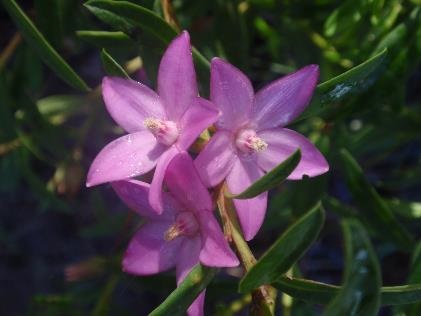Gardening

There are thousands of gardens in Lane Cove. Put together, these make up a large amount of green space which impact on our local environment. Consider the effects of weeds, garden chemicals, fertilisers... managing your garden well is important!
Join the Backyard Habitat program, free for residents who want to plant native plants and provide a space for native animals in their backyard.
Planting local species
Council encourages residents to plant native species indigenous to the local area. This is worthwhile for a number of reasons:
- You can help preserve the historic and aesthetic landscape qualities of the area.
- You can provide valuable habitat for many birds, mammals, reptiles and insects that are still found through out the area.
- Local plants selected with care, are already adapted to the local soils and microclimates, so they often grow more rapidly and need less constant attention.
When deciding which plants to use in your garden, don't forget to consider factors such as soil type, plant height, water usage and aspect (available sunlight).
Growing the Native Plants of Lane Cove by Judy Messer provides a practical guide to setting up a native garden.
Trees and Shrubs that are most suitable for your garden and native to Lane Cove provides a list of useful native plants for gardens.

Living with Wildlife
Our gardens can provide a valuable refuge for many native animals. Tree hollows are becoming increasingly rare and are critical for the survival of over 170 native species in NSW. You may like to Build your own Wildlife Nest Box. This helpful guide provides information to construct quality nest boxes for a number of different wildlife.
Here are some useful tips on living harmoniously with wildlife:
Domestic pets, particularly cats can have a huge impact on our wildlife such as birds and lizards. Keep your cat indoors wherever possible and find out more on how to keep cats safe at home. Discover more about the native animals which live in our bushland and gardens.
Managing your Garden
Some garden plants are capable of spreading beyond the garden boundary and become weeds of bushland and other spaces. Find out about Priority Weeds in Lane Cove and how you can identify and control them in your garden.
It is important for residents who live next to the bush to be “bushfire-ready”, especially during the warmer, drier months. There are several actions you can take to prepare your property and garden for the bushfire season.
Looking After Nature Strips
Nature strips are the Council owned land located between the constructed road and private property (that is, the street verge). Nature strips contribute significantly to the streetscape and visual amenity of local neighbourhoods.
Council encourages residents to walk around their neighbourhood, therefore safe pedestrian access needs to be maintained. It is Council’s responsibility to ensure that members of the public are not injured whilst using this area.
Council maintains the nature strips found adjacent to parks or reserves and Council community facilities. Council also plants and maintains the street trees.
Grassed nature strips are expected to be mowed regularly by neighbouring residents and kept neat and tidy such that they contribute to the general appearance of the street.
Residents are also expected to keep garden plants within their property or along the fence line trimmed back so they don’t obstruct pedestrians walking along the footpath or nature strip or interfere with motorist or cyclist sightlines.
A resident wishing to replace the grass on the nature strip outside their property with native plants or low maintenance garden areas must first apply in writing to Council's 'On the Verge' Program Officer for approval prior to undertaking any such works.
If a resident of the adjacent property is unable physically and financially to maintain the nature strip they can make a Nature Strip Mowing Service Application for Council to maintain the area.
Community Gardens
Council has worked with local community groups to create a community gardens for everyone to enjoy. For those interested in further information or joining the groups see locations and contact information below.
Hughes Park Community Garden is located in Lane Cove West. This is an established group with a newly reconfigured garden layout. Contact lanecovecommunitygarden@gmail.com to register your interest and updates on events and activities. You can also take a look at the Lane Cove Community Garden Facebook.
Stringybark Community Garden is located in Lane Cove North. This is a new small group in the initial phases of setting up. To find out more contact stringybarkcg@gmail.com.
Community Garden Procedures and Guidelines.